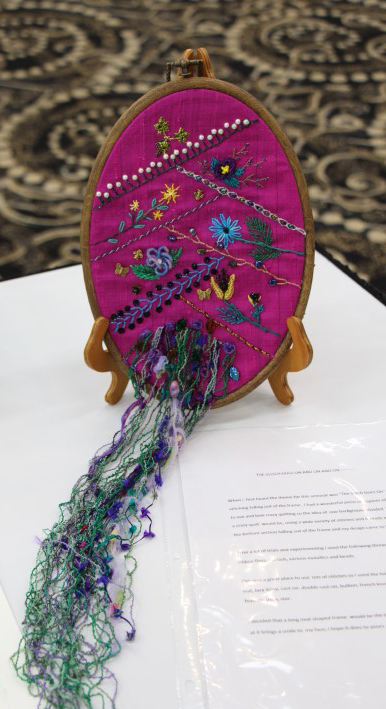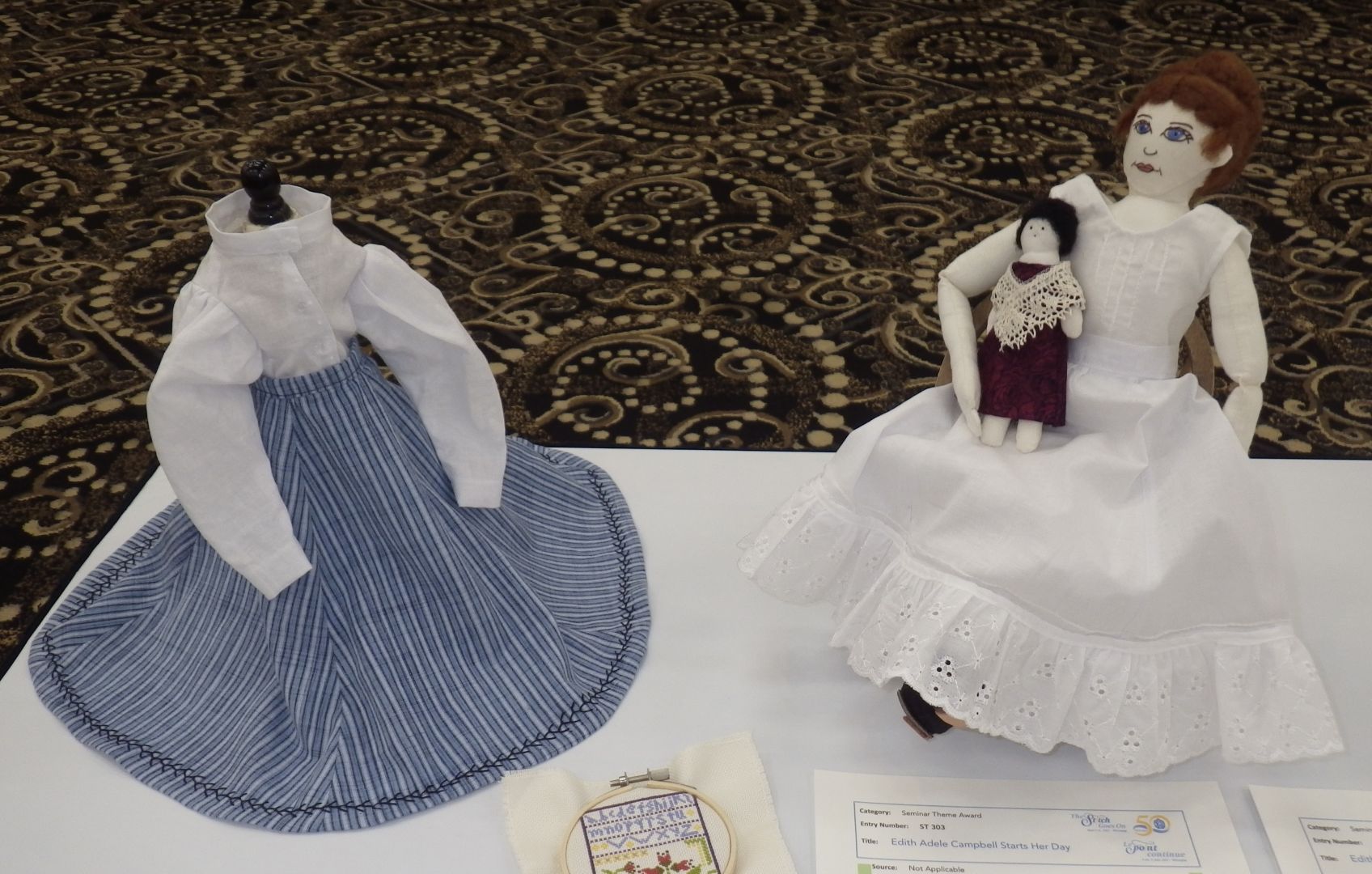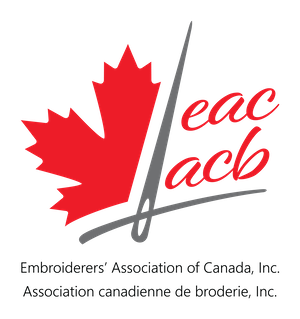EAC/ACB’s 2023 seminar theme was The Stitch Goes On/Le point continue. That theme was interpreted quite differently by the three winning entrants.
First Place: Diana Kelly, Lakeshore Creative Stitchery Guild, The Stitch Goes On & On & On

Diana Kelly’s entry is an original design. As part of the Seminar Theme Award, the entrant provides a statement about their piece. From Diana’s statement:
This oval framed surface stitched piece represents crazy patch with the threads in the bottom section hanging down and the stitches falling off the frame as the stitch goes on and on and on.
When I first heard the theme of this seminar was “The Stitch Goes On.” I thought of stitching falling out of the frame. I had a wonderful piece of dupion silk that I wanted to use, and I love crazy quilting. So, the idea of one background divided into sections, as a crazy quilt would be, using a variety of stitches and threads, with the threads at the bottom section falling out of the frame, and my design came to be. After a lot of trials and experiments, I used the following threads: Brazilian, pearl cotton, ribbon floss, eyelash, various metallics and beads.
I decided that a long, oval-shaped frame would be best to display this design. Looking at it brings a smile to my face; I hope it does to yours as well.
Second Place: Marcella Pedersen, Regina Stitchery Guild, The Stitch Goes On & On & On

Marcella’s Hardanger runner was stitched with #8 pearl cotton on Lugana white opalescent 28-count linen. The design was adapted from a chart by Evelyn MacKay. No statement was submitted.
Third Place: Lorraine Iverach, Winnipeg Embroiderers’ Guild, Edith Adele Campbell Starts Her Day

From her entry statement:
Edith Adele Campbell is ready to start her day. She is getting dressed in multiple layers of hand-sewn clothing. Her mother and grandmother did the embroidery on her skirt and undergarments, and Edith is excited to be learning some stitching techniques herself. She is working on her own embroidery; a simple sampler already stretched and waiting in her hoop. Edith plans to give the finished piece to her mother next Christmas as a thank you for all her patience while Edith practiced her embroidery. Edith is already planning her next project, sewing miniature clothing for her doll. She wonders as she stitches if she will ever have a child of her own to teach how to use a needle and thread.
“The Stitch Goes On” can be interpreted in many ways as illustrated in this entry. If someone is undressed, one can say she doesn’t have a stitch on! Oh my! Getting dressed, therefore, as this little lady is doing, is one practical way for the stitch to go on.
Sewing and embellishing clothing and creating articles of artwork embroidery are literal interpretations of making the stitch go on, with the actual application of thread to fabric. Stitching can go on a wall, too, as examples of art that often become treasured family heirlooms.
A more philosophical interpretation of the theme involves the passage of time and the ongoing interest, education and love of fibre arts. For hundreds of years to the present day, women of all cultures have shared their traditional expertise in sewing and embroidery, passing both practical and artistic techniques from generation to generation, from mother to daughter, from grandmother to granddaughter. In some cultures, men and boys also produce stitched works. Little girls practice stitching by making clothes and accessories for their dolls, creating miniature versions of adult items. Stitching a sampler, a design with letters and numbers and often a moral saying, is another way to reinforce and showcase the rudiments of reading and writing as well as needlework.
Instilling the love of embroidery and continuing an education in fibre arts in the youth, both boys and girls, is an ongoing challenge that will ensure the stitch will go on for generations to come.
This entry is an original design. The jointed stuffed doll is made of cotton muslin with wool roving hair. The garments are also original designs constructed of cotton fabrics with hand-embroidered embellishments. The doll is named after women who played a significant role in the needlework journey of the artist. The doll’s full initials are “EAC” in honour of the Embroiderers’ Association of Canada.

